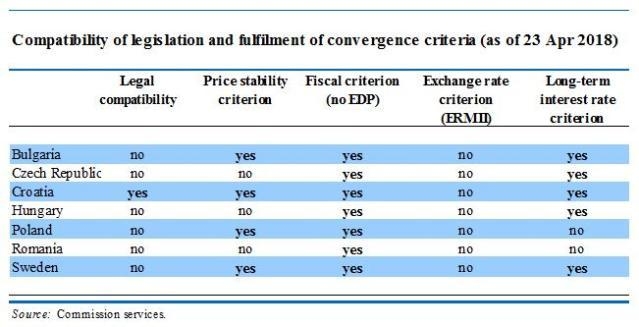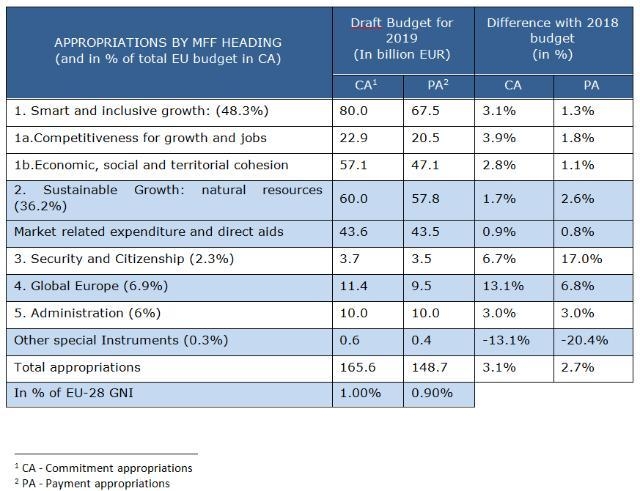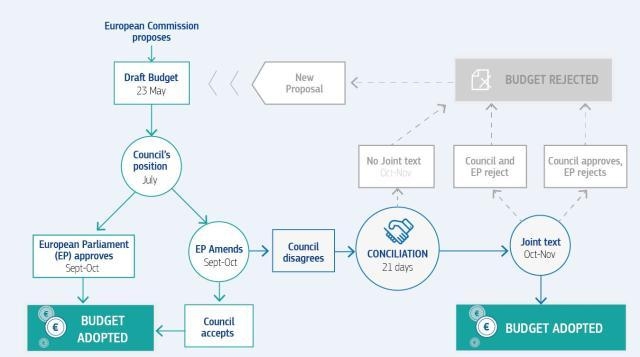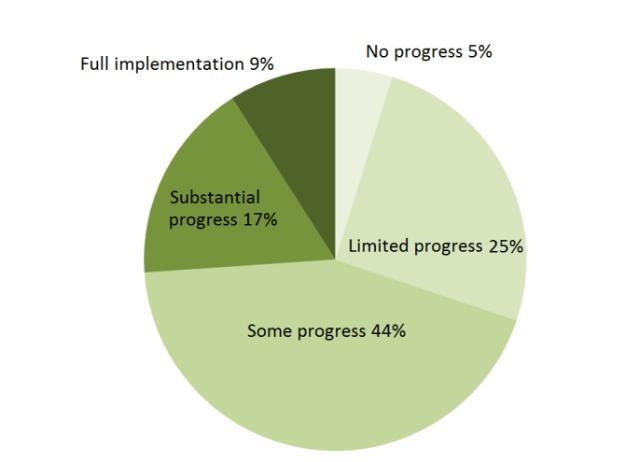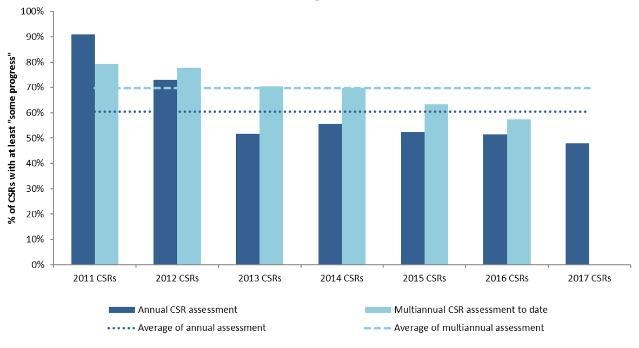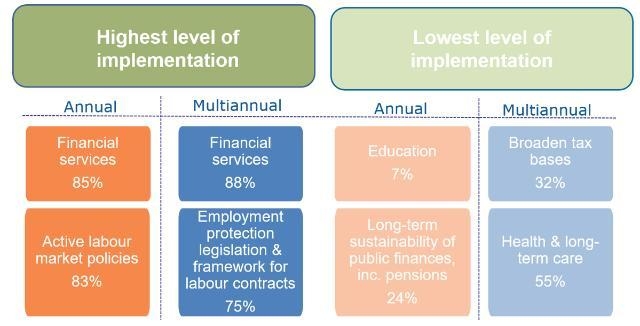Daily News 23 / 05 / 2018
RÉUNION DU COLLÈGE: paquet “semestre européen 2018” du printemps – La Commission adresse des recommandations aux États membres afin que ceux-ci parviennent à une croissance durable, inclusive et à long terme
Aujourd’hui, le vice-président Dombrovskis, la commissaire Thyssen et le commissaire Moscovici ont présenté les recommandations par pays de la Commission pour 2018, en expliquant les orientations de politique économique pour les États membres pour les 12 à 18 prochains mois. L’économie européenne croît à son rythme le plus élevé depuis dix ans; elle est soutenue par un taux d’emploi historiquement élevé, une reprise des investissements et une amélioration des finances publiques. Conformément aux prévisions du printemps 2018 de la Commission, la croissance restera forte malgré une très légère décélération. Les recommandations par pays proposées aujourd’hui s’appuient sur les progrès accomplis dans la mise en œuvre des réformes et visent à tirer parti des perspectives économiques positives pour inciter les États membres à introduire des réformes qui accroîtront la résilience et doperont le potentiel de croissance. La Commission a également pris un certain nombre de mesures dans le cadre du Pacte de stabilité et de croissance. Elle recommande la clôture de la procédure pour déficit excessif visant la France; adopte des rapports concernant la Belgique et l’Italie au titre de l’article 126, paragraphe 3, du TFUE, dans lesquels elle examine leur respect du critère de la dette prévu par le traité; propose que le Conseil adopte une recommandation pour que la Hongrie prenne des mesures appropriées en 2018 en vue de corriger l’écart significatif; recommande pour la Roumanie que le Conseil rende une décision sur les mesures inefficaces et recommande de prendre des mesures en 2018 et 2019 pour corriger l’écart significatif. Il publie également son avis sur le projet de plan budgétaire actualisé (DBP) pour l’Espagne. Un communiqué de presse et un mémo sont disponibles en ligne. (Pour plus d’informations: Christian Spahr – Tel.: +32 229 50055; Christian Wigand– Tel.: +32 229 62253; Annikky Lamp – Tel.: +32 229 5615; Sara Soumillion – Tel.: +32 229 67094)
COLLEGE MEETING: Commission releases 2018 Convergence Report: Review of Member States’ progress towards euro adoption
The Commission has published its 2018 Convergence Report which assesses Member States’ progress towards joining the euro area. The report is based on the convergence criteria, sometimes referred to as the ‘Maastricht criteria’, set out in article 140(1) of the Treaty on the Functioning of the European Union (TFEU). The report covers the seven non-euro area Member States that are legally committed to adopting the euro: Bulgaria, the Czech Republic, Croatia, Hungary, Poland, Romania and Sweden. It finds that these Member States generally display considerable nominal convergence, but none of them currently meet all the formal conditions for joining the euro area. Two of these Member States, Bulgaria and Croatia, fulfil all of the convergence criteria, except for the exchange rate criterion as they are not members of the Exchange Rate Mechanism (ERM II). According to a new Eurobarometer survey, published today, support for joining the euro in the non-euro area Member States covered by the Convergence Report continues to increase. The Convergence Report by the European Commission is published in parallel with the Convergence Report by the European Central Bank (ECB). A press release and memo are available online. (For more information: Christian Spahr – Tel.: +32 229 50055; Annikky Lamp – Tel.: +32 229 56151; Enda McNamara – Tel.: +32 229 58615)
COLLEGE MEETING: 2019 EU Budget: Commission proposes a budget focused on continuity and delivery – for growth, solidarity, security
The Commission today proposed the 2019 draft EU Budget of €166 billion in commitments, investing in a stronger and more resilient European economy and promoting solidarity and security on both sides of the EU’s borders. This budget is the sixth one under the current 2014-2020 long-term EU budget and operates within the limitations set therein. It is designed to optimise funding for existing programmes as well as new initiatives and to boost European added value in line with the Juncker Commission’s priorities. Commissioner Günther H. Oettinger, in charge of Budget and Human Resources, said: “We are proposing an ambitious budget that continues to support our priorities, in particular on investment, jobs, youth, migration, solidarity and security, and that delivers European added value for our citizens. We need stability for the EU and I look forward to reaching an agreement with Parliament and Council as soon as possible.” The proposal is based on the premise that the United Kingdom, following its withdrawal as of 30 March 2019, will continue to contribute to and participate in the implementation of EU budgets until the end of 2020 as if it were a Member State. The European Parliament and the European Union Member States will now jointly discuss this proposal. Earlier this month, the Commission put forward its proposal for a pragmatic and modern long-term budget for the 2021-2027 period. A press release in all languages, but also a memo and a fact sheet in EN, DE, FR are available online. (For more information: Alexander Winterstein – Tel.: +32 229 93265; Maria Tsoni – Tel.: +32 229 90526)
COLLEGE MEETING: Commission proposes new rules for OLAF as a close partner of the European Public Prosecutor’s Office
The creation of a European Public Prosecutor’s Office (EPPO) marks the beginning of a new phase in the fight against fraud affecting the EU budget. In this context, the European Commission is proposing today to amend Regulation (EU, Euratom) 883/2013 concerning investigations conducted by the European Anti-Fraud Office (OLAF). The amendment seeks to ensure that OLAF is equipped to work closely with the EPPO to detect and investigate fraud across the EU. The proposed changes will also clarify OLAF’s tools for the conduct of administrative investigations with a view to ensuring their effectiveness. This concerns in particular checks and inspections, access to bank account information, as well as the tools to fight VAT fraud. “The budget is truly about EU added value. We must ensure that every cent is spent to the benefit of our citizens. This means that the fight against fraud and corruption needs to be more vigorous than ever. We need to ensure that OLAF is fit for purpose and that it works alongside the EPPO in a smooth and efficient manner. We need to maintain a strong OLAF that complements the EPPO’s criminal law approach with solid administrative investigations.” said Günther H. Oettinger, Commissioner for Budget and Human Resources. Today’s proposal to amend Regulation 883/2013 aims to ensure that OLAF becomes a close and reliable partner of the EPPO, and that it continues to conduct administrative investigations to complement the EPPO’s work. OLAF will thus continue playing an essential role in the protection of the Union’s financial interests. The EPPO and OLAF will work in close partnership to ensure – through their distinct but complementary mandates – that all available means are used to counter fraud and to protect taxpayers’ money. A press release in all languages is available online. (For more information: Alexander Winterstein – Tel.: +32 229 93265; Maria Tsoni – Tel.: +32 229 90526)
European Defence Fund: Commission welcomes provisional agreement found on industrial programme
The Commission welcomes the provisional agreement reached yesterday evening by the European Parliament and the Council on the European Defence Industrial Development Programme (EDIDP). The EDIDP is a key pillar of the European Defence Fund, announced by President Juncker in September 2016 and launched in June 2017. It aims to encourage cooperation in developing the technologies and equipment needed to address common defence and security challenges. Elżbieta Bieńkowska, Commissioner for the Internal Market, Industry, Entrepreneurship and SMEs, added: “This programme is part of our wider efforts to establish a credible Defence Union which protects its citizens. With this agreement, we are building EU’s strategic autonomy and boosting the competitiveness of the EU defence industry. Additionally, for the period 2021-2027, as part of the next EU budget, we have just proposed to allocate €13bn for the European Defence Fund.” Under the EDIDP programme, the EU will co-fund projects (€500 million foreseen in 2019 and 2020) that are implemented by at least three undertakings in at least three Member States. For prototypes, up to 20% of the cost could be covered by the programme while for other actions such as design or testing, it can go up to 100%. In addition, projects developed in the context of PESCO or involving SMEs and Mid-Caps that are deemed eligible will be able to benefit from higher co-financing rates. The provisional agreement reached by EU negotiators now needs to be approved by the Parliament and the Council with a view to becoming fully applicable at the beginning of 2019. The European Defence Fund has already started to fund pan-European research projects (more information here). On 2 May, as part of the Commission’s proposal for the next EU long-term budget, the Commission proposed to allocate €13bn for a fully-fledged European Defence Fund. (For more information: Lucía Caudet – Tel .: +32 229 56182, Maud Noyon – Tel .: +32 229 80379)
ANNOUNCEMENTS
Expanding clean energy is a global top priority: European Commission at Mission Innovation and Clean Energy Ministerial
On 23 and 24 May, Vice-President Maroš Šefčovič and the Commissioners Miguel Arias Cañete and Carlos Moedas will attend two Ministerial meetings focussing on the clean energy transition globally. Energy Union Vice-President Maroš Šefčovič and Research Commissioner Carlos Moedas will participate in the Mission Innovation Ministerial in Malmö. This third mission innovation (MI-3), co-hosted by Denmark, Sweden, Finland, Norway, the European Commission and the Nordic Council of Ministers, focuses on accelerating clean energy innovation and boosting public research and development spending in the field of clean energy. Energy ministers along with high-level representatives of business and the research community will celebrate what has been achieved so far and initiate engagement in new areas. Climate Action and Energy Commissioner Miguel Arias Cañete will participate in the Ninth Clean Energy Ministerial (CEM9) in Copenhagen, also co-hosted by Denmark, Finland, Norway, Sweden, the Nordic Council of Ministers, and the European Commission, representing the European Union. Business leaders from the energy sector and high-level representatives from the world of finance will take part. CEM is an important forum to advance the global clean energy transition and promote clean energy technologies. It focuses on the promotion of policies and programs that advance clean energy technologies, share lessons learned and best practices and encourage the transition to a global clean energy economy. Participating countries in both fora represent about 90% of global clean energy investment and 75% of global greenhouse gas emissions. For information and further programme details on the Commission’s website. (For more information: Anna-Kaisa Itkonen – Tel.: +32 229 56186; Anca Paduraru – Tel.: +32 229 91269; Nicole Bockstaller – Tel.: +32 229 52589)
Commissioner Miguel Arias Cañete to discuss clean energy transition at Energy Infrastructure Forum
In the context of the Clean Energy Ministerial (CEM), Climate Action and Energy Commissioner Miguel Arias Cañete will open the annual Energy Infrastructure Forum on 24 May in Copenhagen. The forum was set up as part of the Energy Union strategy, and its aim is to remove technical and regulatory barriers to energy flowing freely across the EU, and discuss major issues relating to infrastructure and EU energy policy. The gathering will bring together representatives of the EU institutions, transmission system operators, project promoters, regulators, energy companies, NGOs and the financing community, to discuss the challenges of developing Europe’s energy infrastructure and building an internal energy market. Ahead of both the meeting, Climate Action and Energy Commissioner Miguel Arias Cañete said: “This year’s Clean Energy Ministerial will provide an important platform for politicians, businesses, researchers and other organisations to demonstrate our leadership in the clean energy transition and to showcase the significant achievements that have already been made. As the world of energy is changing rapidly, so the Clean Energy Ministerial needs to reflect and support such changes. The message should be that expanding clean energy is a global top priority. I am also looking forward to opening the annual Energy Infrastructure Forum in Copenhagen, the key platform for policy-makers and stakeholders to exchange views in this area. We need to ensure that EU action related to energy infrastructure is goal-oriented, operational and comprehensive. A solid and modern energy infrastructure is a must in our Energy Union, and for this we need to foster cheap and easy access to financing. Innovative approaches and technology need to be encouraged, through actions such as the Renewables Grid Initiative awards”. Agenda, background papers and more information about the Infrastructure Forum can be found here. (For more information: Anna-Kaisa Itkonen – Tel.: +32 229 56186; Nicole Bockstaller – Tel.: +32 229 52589)
EU agencies step up cooperation on cybersecurity
High Representative/Vice-President Federica Mogherini and Commissioner for Digital Economy and Society Mariya Gabriel are hosting today the signing ceremony of a Memorandum of Understanding (MoU) between the European Union’s agencies working on cybersecurity and cyber defence. Through this MoU, the European Union Agency for Network and Information Security (ENISA), the European Defence Agency (EDA), Europol’s European Cybercrime Centre (EC3) and the Computer Emergency Response Team for the EU Institutions, Agencies and Bodies (CERT-EU) agree to step up their cooperation to equip Europe with the right tools to deal with new cyber challenges. High Representative/Vice-President Mogherini, who is also the Head of the European Defence Agency, said: “Cyberspace threats do not know of national borders. Cooperation among Member States but also at European level is therefore essential. Europe is stronger when it tackles threats together, in a common and coordinated approach. And this is exactly where this Memorandum of Understanding is key and where the added value of the European Union lies: working together, joining forces, putting the experiences and the knowledge of all at the service of our citizens’ security.” This initiative will contribute to the EU’s cyber resilience and collective security by enhancing information sharing; cooperate on education and training and reinforcing collaboration on cyber exercises. It reflects the inter-institutional cooperation impetus initiated by the Directive on security of network and information systems (NIS Directive) and the European Commission’s cybersecurity initiatives from September 2017. A full press release will be available here at 15:00 CEST. (For more information: Nathalie Vandystadt – Tel.: +32 229 67083; Maja Kocijancic – Tel.: +32 229 86570; Inga Höglund – Tel.: +32 229 50698; Esther Osorio – Tel.: +32 229 62076)
Commissioner Stylianides travels to Washington for High-Level workshop on Ebola response
Commissioner for Humanitarian Aid and Crisis Management Christos Stylianides will deliver a speech on 24 May at the High-Level Workshop on the Ebola Response organised by Georgetown University in Washington, D.C. He will speak about his experience as the EU Ebola coordinator and discuss with his counterparts how the EU and the US can best cooperate to tackle epidemic outbreaks. “Ebola is a common enemy which knows no borders. The latest outbreak in the Democratic Republic of Congo is a stark reminder that we cannot let our guard down. I am convinced that the EU and the US should work more closely in the fight against this deadly disease. We are stronger together,” said Commissioner Stylianides. The Commission is currently supporting international efforts to stem the current outbreak of Ebola and has announced funding and set up humanitarian flight deliveries. Earlier the same day, Commissioner Stylianides will speak on “Strengthening EU-US Cooperation in Emergency Health Response” at a High-Level Luncheon organised by the Center for Strategic and International Studies. He will also have various bilateral meetings with US Government officials. (For more information: Carlos Martin Ruiz De Gordejuela – Tel.: +32 229 65322; Daniel Puglisi – Tel.: +32 229 69140)
First Vice-President Timmermans to visit Germany
On 24-25 May, Commission First Vice-President Frans Timmermans will be in Germany for a series of engagements with citizens, judicial stakeholders and German authorities. On Thursday, in Berlin, he will begin his visit by participating in a meeting of the European Affairs Committee of the Bundesrat. The First Vice-President will then meet with representatives of the German and European Associations of Judges before attending the 44th Conference of the Association of European Judges. In the evening of 24 May, he will travel to Frankfurt an der Oder, on the German-Polish border, for a Cross-Border Citizens’ Dialogue with Citizens from Germany and Poland, alongside Elżbieta Polak, Marshal of Lubusz Voivodeship and Stefan Ludwig, Minister for Europe, Justice and Consumer Protection of the State of Brandenburg. The Citizens’ Dialogue will be livestreamed here. On Friday 25 May, the First Vice-President will meet in Berlin with Helge Braun, Chancellery Chief of Staff and Federal Minister for Special Affairs. (For more information: Christian Wigand – Tel.: +32 229 62253; Tim McPhie – Tel.: +32 229 58602)
Commissioner Navracsics at high-level Education Ministerial conference in Paris: a renewed push for the Bologna Process
Tomorrow and Friday, 24-25 May, Education Ministers from the 48-country European Higher Education Area will meet in Paris for a two-day conference. They will discuss progress in improving higher education systems and enabling students to move more freely across national borders under the so called Bologna process. The latest Bologna Implementation report, published today, shows that progress has been made, notably in implementing the three cycle Bachelor-Master-Doctorate degree structure. However, it also points to the lack of lifelong learning provision in many countries, and the fact that disadvantaged learners across Europe still face barriers to accessing and succeeding in higher education. Commissioner for Education, Culture, Youth and Sport, Tibor Navracsics, will deliver an address on the first day. Ahead of the conference, he said: “The Commission’s vision is of a Europe in which learning, studying and doing research will not be hampered by borders. That is why we aim to build on the solid achievements of the European Higher Education Area and work towards a European Education Area by 2025. Our ambition is to enable EU Member States to intensify and accelerate their cooperation in areas such as mobility, language learning, innovation and mutual recognition of diplomas, and thus also to provide a new impetus for the Bologna process.” At the conference, Ministers will define new priorities for years ahead. Among others they will focus on better access for under-represented and vulnerable groups to higher education, transnational cooperation in higher education and research and innovation. Yesterday, the Commission presented its proposal for Automatic Mutual Recognition of Diplomas and Learning Periods Abroad, Language Learning, as well as plans for a European Student Card as part of a broader push to boost learning mobility. More information on the Bologna process including a brochure entitled ‘The EU in support of the Bologna Process’ published today can be found here. (For more information: Nathalie Vandystadt – Tel: +32 2 29 67083; Joseph Waldstein – Tel: +32 2 29 56184)
Cohesion policy beyond 2020: conference discusses good governance and solid administrations in the future management of EU funds
Tomorrow the Commission is organising a conference in Brussels (Charlemagne building) on “Good Governance for cohesion policy”, open to the press. Commissioner for regional policy Corina Crețu said: “I say it often, good, transparent governance and solid administrations are as important as the money itself to ensure quality EU investments. This conference will give us the opportunity to discuss what tools and what skills are needed for the most effective management of EU funds and which actors to involve for transparent and open institutions.” The keynote address will be given by Deputy Secretary-General of the Organisation for Economic Cooperation and Development (OECD) Mari Kiviniemi. Commissioner for Environment, Maritime Affairs and Fisheries Karmenu Vella will open the conference. Speakers and participants, coming from all over Europe, include Tomislav Donchev, Bulgarian Deputy Prime Minister, Richard Raši, Slovak Deputy Prime Minister for Investments and Information, Pedro Marques, Portuguese Minister of Planning and Infrastructure, Jerzy Kwieciński, Polish Minister for Investment and Development, as well as President of the Committee of the Regions Karl-Heinz Lambertz and MEP Constanze Krehl. In the context of the conference, the Commission will announcethe five countries and regions selected to take part in a new pilot action testing and developing solutions for administrative capacity-building in the post 2020 framework. (For more information: Johannes Bahrke – Tel.: +32 229 58615; Sophie Dupin de Saint-Cyr – Tel.: +32 229 56169)
Upcoming events of the European Commission (ex-Top News)
